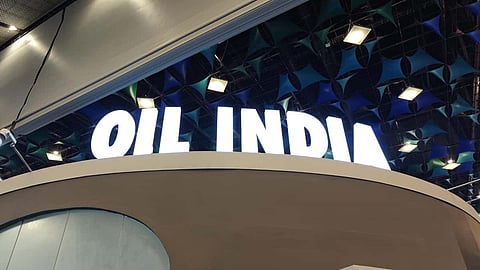

New Delhi: Oil India Ltd (OIL) on Friday reported a sharp decline in standalone profitability for Q2FY26, with Profit after Tax (PAT) falling 43.08 percent to Rs 1,044.02 crore from Rs 1,834.07 crore a year ago, even as standalone revenue from operations held steady at Rs 5,456.72 crore. The company said the drop in earnings was driven primarily by weaker crude prices.
Follow Energy Watch on X
In its statement, OIL said it achieved a standalone PAT of “Rs 1,044 crore in Q2FY26 vis-à-vis Rs 1,834 crore achieved in Q2FY25 due to a sharp drop in crude price realisation from USD 79.33/bbl in Q2FY25 to USD 68.19/bbl in Q2FY26, a drop of 14 percent.” The Board declared an interim dividend of Rs 3.50 per share for the quarter.
Revenue from operations was marginally lower than last year (Rs 5,456.72 crore vs Rs 5,518.95 crore), a decline of 1.13 percent. Standalone operating profit and net profit were both impacted by the sharp reduction in crude oil realisation — which fell by USD 11.14 per barrel year-on-year — despite stable production. Standalone production for the quarter was 1.652 MMTOE, marginally lower than 1.674 MMTOE last year. Standalone net profit margin for the quarter was 19.13 percent, while operating margin was 13.69 percent.
While volumes remained stable and operational performance did not deteriorate meaningfully, the reduction in per barrel realisation significantly compressed upstream margins. A large share of the company’s standalone profitability continues to be supported by other income, which stood at Rs 830.70 crore for the quarter. This reliance on investment and interest income offset part of the decline in operational profitability but could not counter the impact of the drop in crude realisation.
While standalone earnings weakened, consolidated results showed greater resilience. The company said it “sustained its consolidated turnover at Rs 9,175 crore in Q2FY26 vis-à-vis Rs 8,136 crore in Q2FY25”, indicating that refinery operations and subsidiary performance supported the top line even as upstream realisations fell. Numaligarh Refinery Ltd (NRL) remained the largest contributor to consolidated revenue, recording Rs 6,442.77 crore in segment revenue for the quarter and sustaining throughput at 753 TMT, with capacity utilisation of 100.38 percent. The refinery’s performance, coupled with stable crude and gas sales at the group level, lifted consolidated segment revenue before eliminations to Rs 11,899.49 crore.
After inter-segment eliminations, consolidated revenue stood at Rs 9,175.41 crore, an increase of 12.78 percent over the same period last year. Consolidated PAT for the quarter was Rs 1,643.81 crore, which is Rs 599.79 crore higher than standalone PAT. This gap reflects the stabilising effect of downstream operations, subsidiary income and the group’s diversified revenue streams, in contrast to the volatility seen in upstream standalone earnings due to price fluctuations.
Margins at the consolidated level were also stronger. Consolidated operating margin for the quarter was 17.79 percent, while consolidated net profit margin stood at 17.92 percent, indicating that the refinery and other subsidiaries remain critical in supporting group-level profitability, especially when crude prices soften.
A closer look at the segment results shows the divergence between standalone and consolidated performance. On a standalone basis, segment revenue for the quarter was led by crude oil at Rs 3,512.25 crore, followed by natural gas at Rs 1,418.65 crore and pipeline transportation at Rs 444.87 crore, with smaller contributions from LPG and renewables. Standalone segment results (profit) for the quarter were Rs 1,591.53 crore for crude, Rs 688.77 crore for natural gas, and Rs 302.22 crore for pipeline operations, reflecting the direct impact of lower crude realisation on upstream earnings.
At the consolidated level, the segment picture was markedly different due to the presence of NRL. Consolidated segment revenue before eliminations stood at Rs 11,899.49 crore, driven by Rs 6,442.77 crore from refinery products, Rs 3,512.25 crore from crude, Rs 1,418.65 crore from natural gas, and Rs 444.87 crore from pipeline transportation. Consolidated segment profit during the quarter amounted to Rs 1,591.53 crore for crude, Rs 688.77 crore for natural gas, Rs 302.22 crore for pipeline, Rs 1,013.03 crore for refinery products, and Rs 59.96 crore for renewables, underscoring the significant role of the refinery business and group entities in strengthening overall profitability.
Profitability for the quarter was further weighed down by provisions and charges recorded during the period. The company booked a Rs 44.36 crore penalty for unfinished work related to its exit from an overseas block in Gabon and recognised an impairment provision of Rs 187.53 crore linked to the same project. In addition, OIL provided Rs 210.24 crore in the quarter towards disputed service tax and GST on royalty, with the cumulative provision on this matter rising to Rs 4,299.49 crore as of September 30, 2025. These provisions added to the downward pressure on reported earnings for the quarter.
Follow Energy Watch on LinkedIN
OIL reported several operational milestones during the quarter. The company said NRL “created history with the inauguration of India’s first 2G bioethanol plant… that uses bamboo as feedstock”, marking a key step in its biofuels expansion strategy. It also reported the “mechanical completion for upgradation of facilities of the Numaligarh–Siliguri Product Pipeline (NSPL)”, a project aimed at strengthening product evacuation capacity and supply chain efficiency. Further, OIL said its “4 percent interest in Area-1 Offshore LNG Block in Mozambique… under force majeure since May 2021, has now been lifted in November 2025”, potentially allowing development and monetisation efforts in the long-stalled asset to resume.
